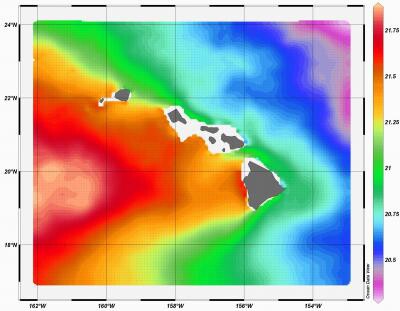The Earth’s oceans are continually heated by the sun, creating a temperature difference between deep and shallow water. This temperature difference contains a vast amount of solar energy, which can potentially be harnessed to generate electricity. Ocean Thermal Energy Conversion (OTEC), involves placing a heat engine between warm water collected at the ocean’s surface and cold water pumped from the deep ocean. Like a ball rolling downhill, heat flows from the warm reservoir to the cool one. The greater the temperature difference, the stronger the flow of heat that can be used to do useful work such as spinning a turbine and generating electricity.
The history of OTEC dates back more than a half century. But although the total energy available is one or two orders of magnitude higher than other ocean energy options such as wave power, the technology has never taken off. This is largely because of the relatively low cost of oil and other fossil fuels and the small magnitude of the temperature difference makes energy extraction comparatively difficult and expensive, due to low thermal efficiency.
Taking sides
Because the places where large OTEC facilities would be most cost effective is where the ocean temperature differentials are the greatest, locations closer to the equator are seen as the most viable. Now researchers at the University of Hawaii at Manoa say that the leeward side of Hawaiian islands are better suited than the windward side for future ocean-based OTEC energy plants. This is because the temperature differential is about one degree Celsius greater on the leeward (western) side of the Hawaiian Islands than that on the windward (eastern) side.

This small difference translates to 15 percent more power for an OTEC plant, says the University of Hawaii's Gérard Nihous, whose theoretical work focuses on driving down cost and increasing efficiency of future facilities, the biggest hurdles to bringing the technology to the mainstream.
Efficiency
Earlier OTEC systems had an overall efficiency of only one to three percent, but current designs under review should be able to operate closer to the theoretical maximum efficiency of between six and seven percent. Although this is still low, OTEC plants can be configured to operate continuously as a Base load power plant to provide the minimum amount of power that a utility company must make available to its customers."Testing that was done in the 1980s clearly demonstrates the feasibility of this technology," says Nihous. "Now it's just a matter of paying for it."
OTEC appears to be attracting more interest as a renewable energy source. OTEC technology is used to power the SOLO-TREC autonomous underwater vehicle, and in March this year, the U.S. Department of Energy selected Lockheed Martin to receive two grants totaling US$1 million to advance the technology commercialization of OTEC. Lockheed Martin's experience with OTEC technology dates back to the 1970s when the company built “Mini-OTEC.” This early prototype remains the world’s only floating OTEC system to generate power in excess of what is required for self-sustainment. Signs are it won’t hold that title for much longer.





